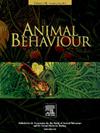乐观主义者是什么样子的:大鼠认知偏差的时间稳定性及其与其他个体特征的联系
IF 2.3
2区 生物学
Q2 BEHAVIORAL SCIENCES
引用次数: 0
摘要
乐观/悲观的概念源于人类的心理,在动物福利科学中越来越流行。通常,所谓的判断偏差测试用于研究对不同影响操纵的乐观程度。然而,最近越来越多的证据表明,判断偏差不仅反映了情感状态,而且可能涵盖了一个特质维度,这意味着一个人的乐观程度随着时间的推移是稳定的。为了促进这一新兴研究领域的发展,我们在这里旨在通过在触觉判断偏差测试中反复测试一组李斯特兜帽大鼠来全面表征乐观和悲观大鼠。为了研究与其他行为特征的潜在联系,我们还评估了大鼠的焦虑和探索行为,它们的偏侧性以及它们对人类诱导的游戏行为的声音反应。此外,我们研究了基础粪便皮质酮代谢物的浓度,以记录下丘脑-垂体-肾上腺皮质的活性。因此,我们采取了两次所有措施来评估随着时间的推移的稳定性。与之前的研究相比,我们在本研究中没有发现乐观水平暂时稳定,鼓励进一步研究可能影响或调节不同生命阶段乐观水平稳定性的潜在因素。此外,我们没有检测到相关行为的套件,呼吁更多的研究环境和/或物种对这种联系出现的影响。尽管如此,我们的研究结果提供了越来越多的证据,证明某些个体间的行为差异,如探索性运动、发声、焦虑样行为和侧边性,以及下丘脑-垂体-肾上腺皮质活动,确实在时间上是稳定的,因此可以被认为是动物个性的一个方面。本文章由计算机程序翻译,如有差异,请以英文原文为准。
What it is like to be an optimist: temporal stability of cognitive bias in rats and its link to other individual traits
Originating from human psychology, the concept of optimism/pessimism has become increasingly popular in animal welfare science. Typically, so-called judgement bias tests are used to study optimism levels in response to different affect manipulations. Recently, however, evidence is growing that judgement biases not only reflect affective states but might also cover a trait dimension meaning that the optimism level of an individual is stable over time. Contributing to this emerging field of research, we here aimed to comprehensively characterize optimistic and pessimistic rats by repeatedly testing a cohort of Lister Hooded rats in a tactile judgement bias test. To investigate potential links to other behavioural traits, we also assessed the rats' anxiety-like and exploratory behaviour, their laterality and their vocal response to human-induced play behaviour. Furthermore, we studied concentrations of basal faecal corticosterone metabolites to record hypothalamic–pituitary–adrenocortical activity. Therefore, we took all measures twice to assess the stability over time. In contrast to previous studies, we did not find optimism levels to be temporally stable in the present study, encouraging further research on potential factors that might affect or modulate the stability of optimism levels within and across different life phases. Furthermore, we did not detect suites of correlated behaviours, calling for more research on the impact of context and/or species on the emergence of such links. Nevertheless, our results contribute to the accumulating evidence that certain interindividual differences in behaviour, such as exploratory locomotion, vocalizations, anxiety-like behaviour and laterality as well as hypothalamic–pituitary–adrenocortical activity, are indeed stable across time and hence can be considered aspects of an animal’s personality.
求助全文
通过发布文献求助,成功后即可免费获取论文全文。
去求助
来源期刊

Animal Behaviour
生物-动物学
CiteScore
4.60
自引率
8.00%
发文量
236
审稿时长
10.2 weeks
期刊介绍:
Growing interest in behavioural biology and the international reputation of Animal Behaviour prompted an expansion to monthly publication in 1989. Animal Behaviour continues to be the journal of choice for biologists, ethologists, psychologists, physiologists, and veterinarians with an interest in the subject.
 求助内容:
求助内容: 应助结果提醒方式:
应助结果提醒方式:


